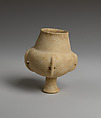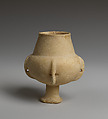On loan to The Met The Met accepts temporary loans of art both for short-term exhibitions and for long-term display in its galleries.
Marble vase with high foot and lug handles
Technical analysis: Ultraviolet-induced visible light luminescence examination
This marble jar is complete with a large part of the rim and foot restored. It has a hemispherical body, a tall conical neck and an unusually cylindrical and slender, high pedestalled foot that is solid. The body of the vessel resembles an inverted sea urchin with four long, crescent-shaped lugs arranged crosswise and perforated for its suspension. An incised line delineates the top of the rim and the flared edge of the foot.
The round bodied jar with four equidistant, vertical pierced lugs on the shoulder, a tall tapering collared neck and pedestal foot reminded modern Cycladic islanders of the glass oil lamp, or ‘kandila’, that they suspended to illuminate their churches and chapels, hence their common modern designation. Pat Getz-Gentle observes that examples with a tall conical collar and foot, each with a marked taper, a broad hemispherical body with long slender lugs that follow the contour of the wall, rising from it fluidly near the flat shoulder and merging with it again on the underside to give the effect of the broadening belly into aellipsoidalal shape are likely to be works of the same artist responsible for most of the extant examples and whom she calls Kandila Sculptor A. (1)
The surface is in relatively good condition with occasional calcareous accretion, especially at the interior.
Sandy MacGillivray and Wendy Walker
(1) See Getz-Gentle, Pat. 1996. Stone Vessels of the Cyclades in the Early Bronze Age. pp. 26-35, University Park: Pennsylvania State University Press.
This image cannot be enlarged, viewed at full screen, or downloaded.
This artwork is meant to be viewed from right to left. Scroll left to view more.





